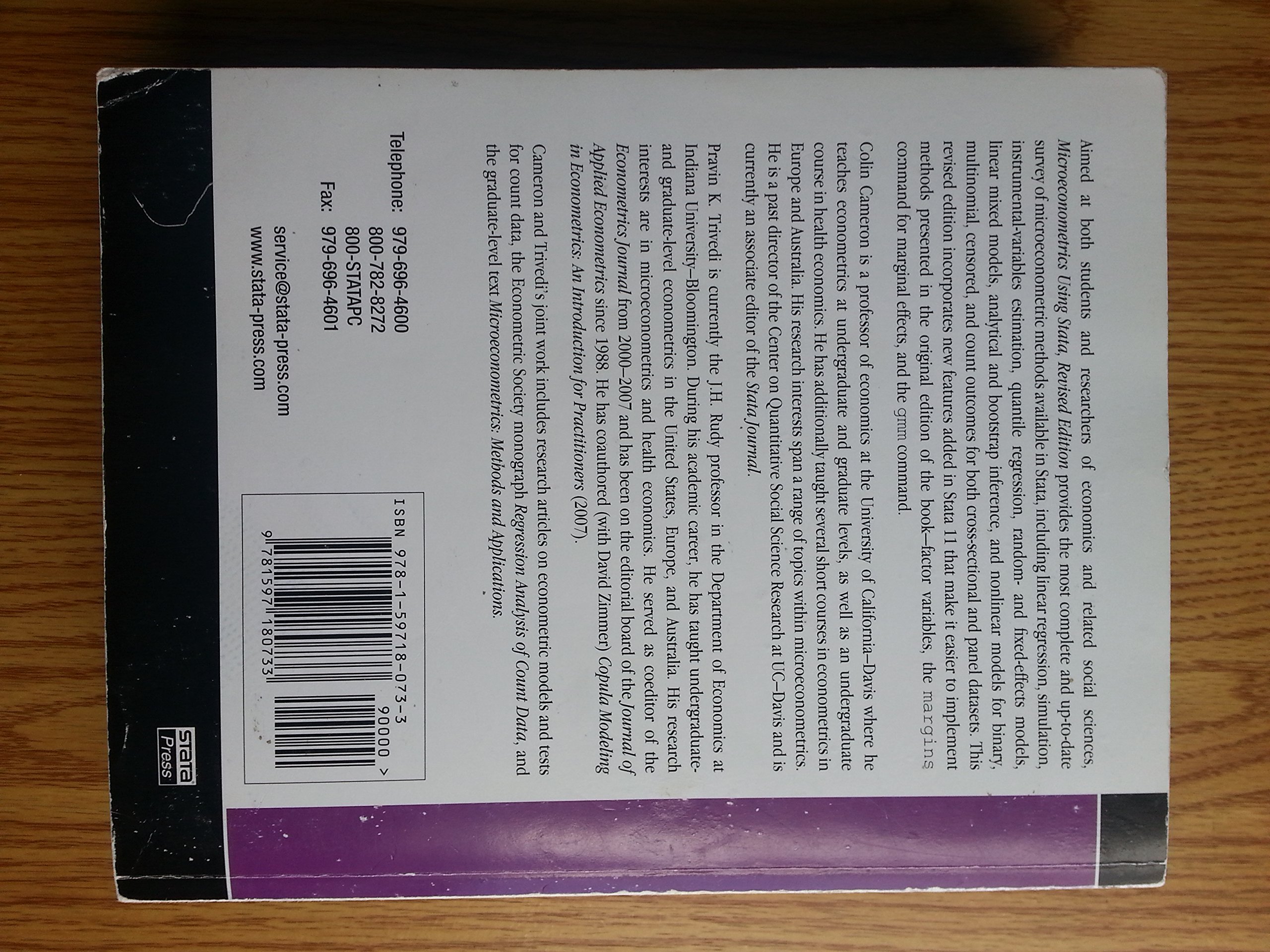




Full description not available
M**.
Should be Required Text for Econometrics Classes
This book is terrific. It provides a nice bridge between the Stata manuals and traditional econometrics textbooks (like Wooldridge or Greene). It gives details not only on the Stata commands, but also context for when you might choose different model specifications or tests.The examples are great. For instance, in section 5.3 "Modeling heteroskedastic data" using GLS, the authors describe two different ways to deal with heteroskedasticity: robust standard errors and FGLS. First they walk you through creating a simulated dataset, performing OLS estimation, then performing OLS with heteroskedastic-robust standard errors (using the "robust" option), and compare the results. Next they show you how to plot the errors to visualize the nature of the heteroskedasticity, as well as how to perform different tests for heteroskedasticity in Stata (and which ones assume normality). Then they walk you through step-by-step how to implement FGLS (the second method), concluding with a discussion of how to augment FGLS with weighted least squares for robustness.I love that it is concise but thorough, and very well organized. The cross-references help a lot when the authors refer to something that they've explained in more detail elsewhere.I only wish I had discovered it during my first semester of graduate level econometrics. I highly recommend it, and think it would be great if professors required it (or at least encouraged their students to get it). It's appropriate for upper-level undergraduate or master's level econometrics classes.
S**E
Best book for modeling in STATA
This is an excellent econometrics book for people who want to USE econometrics and still understand, theoretically, the difference between the models. There are brief descriptions of the theory (including equations) about each model before a very detailed explanation about how to code the model into STATA. I've taken several Econometrics courses and, for me, the challenge has typically been, "yes, but how do I transform my data to do that in real life". Answers are here as long as you are comfortable with using the typical STATA manual instructions. I'd say the advantage of this book over the help manual is how nicely all the models are packaged together. I found myself simply reading through the book and trying models and robustness checks I might not have previously thought of. It covers everything from cross-sectional to panel, including bootstrapping and simulations. It also includes some handy graphing techniques.Coupled with the help guide already installed in STATA 11, this book is perfect for taking data from a raw form and transferring it into the most up-to-date models. The applications go much further than a grad school textbook.
J**N
a godsend
I'm finishing up my undergraduate in econ, and I've been working really hard on doing applied research using Stata, and this book has been an absolute godsend. I'm taking Econometrics right now, and I have an actual textbook for the class, but I decided to buy this book too, and it has explained Stata better than either my professor or textbook has at all. There's a massive amount of information to the book, but thanks to incredibly good organization, and a detailed index, the book works great for either either reference or reading cover to cover
E**V
Must have STATA book!
I have Ph.D. in economics, and I use STATA for my research a lot. As experienced applied econometrician, I can say that this is a "must have" book if you do a lot of applied econometrics.It is a well written book, and it is very easy to read it. This book is a "how to do" book. You will not find a lot of long explanations of different econometric concepts in it, instead you will find a brief and straight to the point information and guidelines plus tons of examples! All the examples are accompanied with STATA code, so you always know how to get the results that you see in the book, and as a result it is always easy to adjust the code for your needs!I would definitely recommend this book to all applied econometricians who use STATA as well as to people who want to learn how to use STATA!
R**A
Great instruction
This is a great book it's all about how to write the code rather than theory which for me is more useful. Great examples of both code and output that shows you where and how to add things.
S**M
Excellent text or independent learning.
Stata is the package that virtually all microeconometricians use. This is a great book for learning Stata. It is also a great book for learnning microecoometrics. It is the best book for learning microecoometrics with Stata.A capable econometrician can teach him/herself Stata independently with the book. It's the perfect text for an uppper level undergraduate, or graduate applied microeconometrics class.Explains standard topics well and also includes sections on more recent research such as weak instruments.
S**U
The best Stata book I have ever had
The book is very practical, if you want to know the theory part, you can get 'Microeconometrics -methods and applications by Cameron and Trivedi' But need to be careful about the wrong examples they use. For example, heckman correction, they use same independent variable list for regression and selection rule but in that case the parameters would not be identified, they mentioned that at the very end of the example very briefly
G**N
Straightforward and easy to understand
Great book. It has solved all my problems. If you are a beginner on Stata, this book will teach you all the basic stuff. Moreover, if you are not a beginner, but you have some doubts on how running some method, this book will also help you.
Trustpilot
2 weeks ago
1 month ago